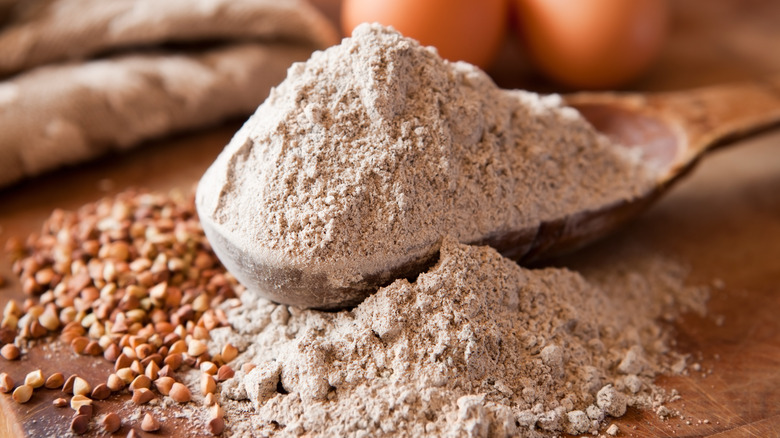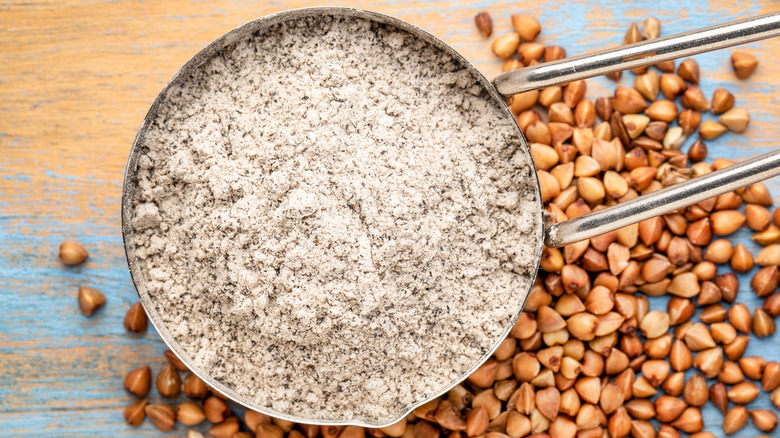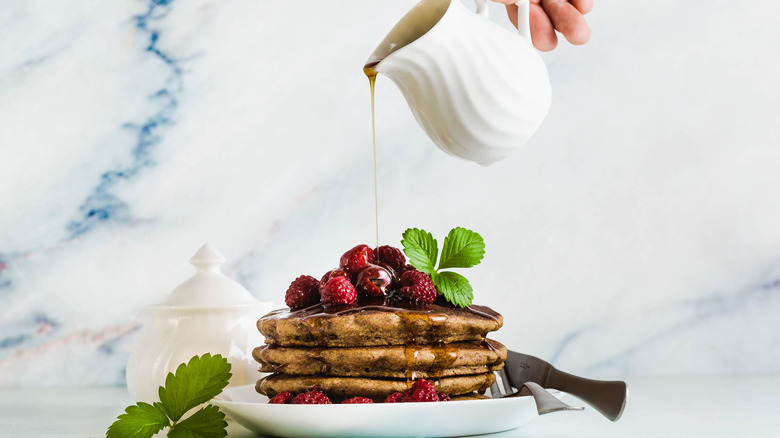Is Buckwheat Flour Gluten-Free?
Whether you have Celiac disease or you just want to limit the amount of gluten in your diet, you might be overwhelmed determining which food ingredients are truly gluten-free. It's pretty common knowledge that all forms of barley, wheat, rye, and triticale contain gluten, but it can be particularly confusing when it comes to ingredients with "wheat" in the name that can still be safe to eat. Case in point: buckwheat.
Despite its name, it isn't associated with wheat at all. Its seeds are considered pseudograins, which means that they look like grains but aren't classified as such on a botanical level. While grains are plant foods from the Poaceae family, pseudograins come from different plant groups. Buckwheat comes from the Polygonaceae family and is more similar to rhubarb. The seeds contain more of the antioxidant rutin, which offers many nutritional benefits, too.
Bear in mind that buckwheat is gluten-free in its natural form, but cross-contamination is a possibility when it's processed into flour if the equipment used also processes ingredients containing gluten. To make shopping for gluten-free products easier, the U.S. Food and Drug Administration requires foods labeled "gluten-free" to contain less than 20 parts per million. For these reasons, it's important to look for a "no gluten" or similar label to confirm that the buckwheat flour you're buying is, in fact, free of gluten. Then, you can be assured of using it safely in your cooking and baking recipes at home.
Replacing gluten-containing flour with buckwheat
According to a Whole Foods Forecast, buckwheat is a hot food trend in 2024 and has been seen in various dishes. The most common involves replacing all-purpose flour with buckwheat flour, which can be done for all kinds of recipes. It pairs best with deep, dark flavors in sweet baked goods — such as chocolate and fruits — and rich, salty flavors in savory goods, such as cured meats and cheeses.
Using buckwheat flour instead of wheat will give baked goods an earthy and savory flavor, but you can combine it with a mild-tasting flour — like sweet rice, sorghum, and oat — so that it's not overpowering. Cassava flour can prevent soggy gluten-free bread while creating a softer flavor as well. Another reason to combine buckwheat with other flours is because there's no gluten. Try substituting 15% of the flour with buckwheat for recipes that call for yeast and 25% for recipes that don't — then, replace the remaining total flour required with another wheat alternative, such as rice or almond.
On top of that, foods made with buckwheat flour will have a different texture than those made with all-purpose flour. Without gluten, the finished product will be denser, more crumbly, and flatter. Fortunately, you can add carbonated water to gluten-free recipes for more airy, fluffy results. You can include extra liquid for better gluten-free items, too — it only takes an additional 2 or 3 tablespoons of liquid for each cup of flour.
Making popular buckwheat flour recipes
You can use buckwheat flour to make everything from cookies to pasta. Since gluten-free bread can be so expensive, a lot of people like to make their own loaves for a more affordable option. Generally, it can take an extra 10 to 20 minutes to bake buckwheat bread over the time needed for wheat loaf. The flour is versatile for different bread types, though; use it for chocolate banana, classic sourdough, and pumpernickel breads.
Buckwheat flour is also one of several ingredients that will change how you make pancakes. Buckwheat gives pancakes a denser texture and a richer flavor, but since it absorbs moisture, you might need to add extra milk to the batter before pouring it into your pan. Warm maple syrup, a dollop of butter, and a spoonful or two of berries are excellent complements to these flapjacks.
Another popular buckwheat flour recipe is Japanese soba noodles, which require no substitution from all-purpose flour since they are traditionally made with buckwheat already. You can practice the art of making your own soba noodles — which requires xanthan gum, konjac starch or a similar ingredient for binding — and a pasta machine to create the strands. Or, purchase premade Juwari noodles (made from 100% buckwheat) to add to a broth. You can even use soba noodles in cold salads, which creates a distinct chew and nutty flavor.



